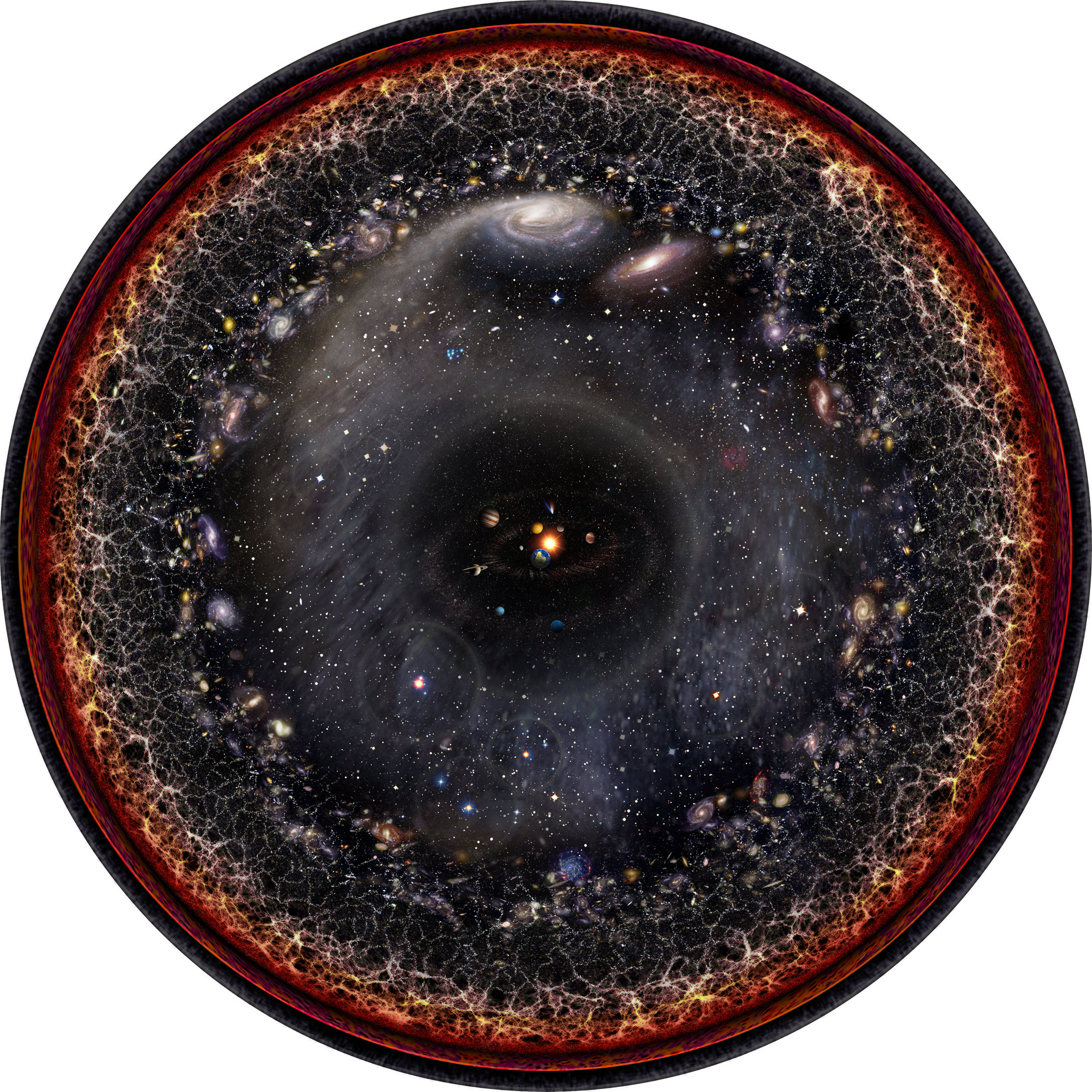This star map shows the Houston sky at 10 pm CDT on June 1, 9 pm CDT on June 15, and dusk on June 30. To use the map, put the direction you are facing at the bottom.
The Big Dipper is high in the north. From the Big Dipper’s handle, arc to Arcturus and then speed on to Spica in the south. Jupiter is in Virgo, near Spica in the south. Cygnus, Lyra, and Aquila form the Summer Triangle in the east, as Scorpius and Sagittarius rise in the southeast. Summer has arrived. Watch Saturn between Scorpius and Sagittarius in the southeast.
What’s Happening In Our Planetary Neighborhood

Artist’s logarithmic scale conception of the observable universe with the Solar System at the center, inner and outer planets, Kuiper belt, Oort cloud, Alpha Centauri, Perseus Arm, Milky Way galaxy, Andromeda galaxy, nearby galaxies, Cosmic Web, Cosmic microwave radiation and Big Bang’s invisible plasma on the edge. Source: Wikimedia Commons. Author:Unmismoobjetivo
Jupiter is well placed for evening viewing. Face south at sundown to see the King of Planets. Only the Sun, the Moon, and Venus outshine Jupiter.
Saturn is up all night long this month. The actual date of opposition, when the Sun, Earth, and Saturn are aligned and Saturn thus rises right at sundown, is June 15. However, as of June 1, Saturn is already up before twilight ends. Face east-southeast at dusk to the lower left of reddish Antares. Saturn won’t be nearly as bright as Jupiter, but easily outshines the stars right near it.
Venus remains a brilliant morning star this month. Look in the east at dawn. Venus shifts northward each morning, and outshines everything in the sky except the Sun and the Moon.
Mars is lost in the Sun’s glare and out of sight all summer.
At 11:24 pm CDT on Tuesday, June 20, the Sun is directly overhead as seen from the Tropic of Cancer, the farthest point north where the Sun ever appears overhead. This means that Earth’s North Pole is tilted towards the Sun as much as possible towards the Sun, and the Sun appears higher at midday than on any other day of the year. We also have more daylight on June 20 than on any other day of the year. Therefore, we call June 20, 2017, the summer solstice. Below the equator, the Sun is as low at midday as it ever gets, and there is less daylight than on any other day of the year. For them, this is the winter solstice.
A bright comet, Comet Johnson, is in June evening skies! ‘Bright’ doesn’t quite mean naked-eye; its magnitude of 6.9 makes just too dim to just look up and see. (The Moon, approaching full on June 9, won’t be helping. ) Binoculars, though, will easily reveal the comet near the bright star Arcturus in Bootes. A chart showing its position during early June is here:
http://www.skyandtelescope.com/observing/comet-johnson-makes-a-splendid-sprint-through-bootes/
Comet Johnson should brighten slightly until its closest approach to Earth on June 5, and remain about as bright through closest approach to the Sun (perihelion) on June 12. After that, not only will it begin to fade, but its trajectory rapidly takes it southward in our sky. By the end of next month, Comet Johnson is hard for us to observe. Incidentally, this comet is on a hyperbolic orbit. Once it swings around the Sun, it will leave the solar system and never return.
Moon Phases in June 2017:

First drawing of the moon through a telescope made in 1609. Artist: Thomas Harriot. Source: Wikimedia Comons.
1st Quarter June 1, 7:42 a.m. , June 30, 7:51 p.m.
Full June 9, 8:09 a.m.
Last Quarter June 17, 6:32 a.m.
New June 23, 9:30 p.m.
On most clear Saturday nights at the George Observatory, you can hear me do live star tours on the observation deck with a green laser pointer. If you’re there, listen for my announcement.
Clear Skies!







